If you are new here, don’t forget to check our Discord Channel. it’s free for everyone!
Hello everyone, I managed to win the last Sunday Pioneer Challenge with Boros Convoke. The deck is relatively new to the format, so it’s far from being solved and I’m sure some flex slots and sideboard options can change in the future. However, I feel that I’ve spent enough hours on the archetype that I’m ready to share my thoughts with you since so many of you were asking for an article about this deck as soon as possible since you have your RCQs to win this and next weekend.
Because the development of the archetype is not done yet, don’t be surprised if some parts of this article will be outdated relatively soon. I did my best to show you not only my current 75, but the options you have in this archetype as a whole. So far we don’t have answers to some questions, for example, whether you should play Burning-Tree Emissary or Clarion Spirit and Jegantha instead, what’s the best way to utilise flex slots, or even how many lands the deck should play. Do your testing and try to find answers, or just believe me and hope for the best. Once the decklist settles, I’ll update the primer so it will be more up-to-date.
At the end of this article, you’ll find my latest decklist and a mini sideboard guide. A regular one will be posted most likely next week and when it’s posted, I’ll delete the mini sideboard guide from this primer. I hope my write-up will be useful for you and you’ll do well in your tournaments. If you want to support me as a content creator, consider signing up and becoming a premium user – you’ll get access to the full Convoke sideboard guide in the future, as well as many other sideboard guides and high level texts about Pioneer and Modern.
Introduction
Boros Convoke is an aggro deck that tries to flood the board with cheap creatures and use them to either cast Knight-Errant of Eos or Venerated Loxodon early or push the damage with Reckless Bushwhacker. The combination of fast kills (your best draws can finish the game on turn three!) and being naturally advantaged versus decks with a lot of point removal makes Boros Convoke a very scary deck to play against.
Why should you play Boros Convoke?
I always believed that being proactive, asking questions and forcing the opponent to have the right answers is the best place to be in Magic. Convoke fits this philosophy – it’s very stable at creating wide board states and has multiple ways to convert them into either mana advantage or damage. The major draw to the archetype is that the tools that are commonly played to stop aggro decks in Pioneer aren’t very effective against Convoke. One for one removal matches up poorly versus both cards that create two or three creatures and Knight-Errant of Eos. Blockers are good to stall the game a bit, but eventually we should have enough creatures to punch through, especially with pump effects. The only way to stop it is to have the right mix of creature removal, blockers and some other disruptive elements like discard or counters or just dedicated cards to deal with wide boards, for example, sweepers. Luckily, not a lot of decks are well-suited to stop the deck in its tracks and as a result, you’ll get a lot of game ones basically for free. Some of you would ask what if the opponent is prepared or the matchup is bad for us? Boros Convoke has a relatively high percentage of free wins with its broken starts. Turn two Gleeful Demolition into a Convoker, followed up by Reckless Bushwhacker on turn three should win versus everything in the format and in my opinion this is what makes this deck great. Boros Convoke reminds me of Affinity from the old days of Modern.
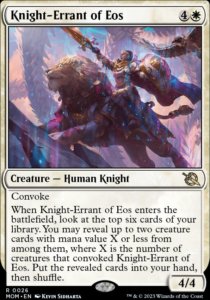
What are the deck’s biggest weaknesses?
While the deck is very good at doing its thing, it can be stopped if the metagame wants to do so. Sweepers in different forms are available in nearly every colour. White has Temporary Lockdown, Depopulate and Farewell, Red has Brotherhood’s End and End the Festivities, Black has Ritual of Soot, Extinction Event and Languish, just to name a few, and you’ll find even better cards if you’re willing to dip into multiple colours, for example, Supreme Verdict or Hidetsugu Consumes All. Even Mono Green, which is famously a colour that’s poor at dealing with large swaths of creatures, has access to The Filigree Sylex via Karn’s wishboard. It’s hard to play around them and sometimes you’ll have to accept that you’ll lose to them – but it’s what we signed up for when we decided to play an aggressive, linear deck. At least three mana sweepers don’t take care of everything – the difference in the mana value or toughness will let you keep at least some of your creatures on board after the board wipe happens, so you’ll be able to finish the job with your remaining resources. The deck can also rebuild quite fast – after all, we can produce more than one creature per card.
The other risk of playing the deck is that it’s so focused on its own plan that we can’t afford to interact that well with what our opponents are doing. So if we stumble a bit or the opponent presents a combo kill, we usually can’t do much about it. Cards like Giant Killer and sideboard interaction can help, but we’ll never be able to control the board as well as other decks in the format can. At least turn two Loxodon can act as an answer to everything.
Boros Convoke – analysis card by card
From a deckbuilding perspective, Convoke is a typical extremely linear deck with bad cards that when combined together can support few powerful cards to create an overwhelming advantage. We can separate maindeck cards into three categories: enablers, payoffs and flex slots.
Enablers
Gleeful Demolition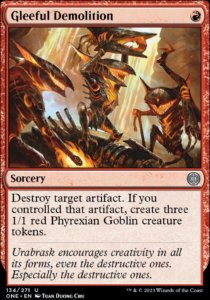
Without this card, the archetype wouldn’t be able to exist. The whole deck needed to be built in a way to support it properly, but it’s still worth doing so. The curve of turn one Voldaren Epicure/Thraben Inspector into turn two Demolition + Convoker is close to unbeatable and it’s hard to stop since not a lot of decks play instant speed Shatter effects. The other good opening is turn one Ornithopter + Demolition into turn two Invasion of Gobakhan and flipping it on the same turn, as it snowballs extremely quickly. Gleeful Demolition is also a great card with Reckless Bushwhacker because it creates a lot of bodies to be pumped. And don’t forget about its secret mode – it can also destroy opposing artifacts!
Thraben Inspector and Voldaren Epicure
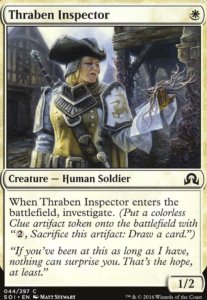
In this deck they both serve a similar role – they cost one mana and create an artifact for Gleeful Demolition to destroy. They are also mana neutral plays when you want to cast Convokers. Inspector is slightly better in general since it’s a white creature for convoke, has two toughness, produces a better token and so on. Epicure is a bit better basically exclusively in tight race situations, thanks to the ETB ping trigger.
Don’t forget both Clue and Blood tokens are not only to be destroyed to get three 1/1s – you can use them in mid game to find cards you need.
Ornithopter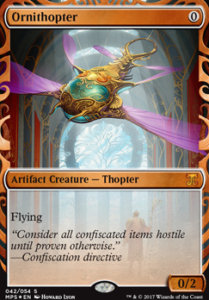
The 0/2 flyer deserves its own category, as it does a lot of small things for the deck. It’s a 0 mana creature, so it can act as a Mox for Convokers – important when the opponent tries to slow us down by killing our early threats. It flies, so it can deal free damage in board stalls after getting pumped. It’s a great target for Gleeful Demolition, especially when you go for it on turn one. Just watch out when you do so – killing it in response will fizzle the Demolition. Ornithopter is also an important piece of the puzzle during Bushwhacker turns, as it allows you to Surge off of two mana. Since it’s free and casting it later can be beneficial, I recommend keeping it in hand unless you have a good use for it.
‘Two mana get two 1/1s’
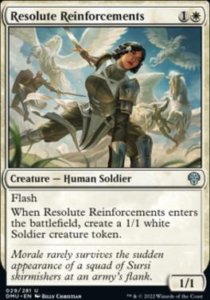
This is our safe way to produce a lot of creatures in early turns to power up our payoff spells. They are good versus points removal because the opponent can’t trade one for one with them easily. In convoke turns, they are mana neutral. I’m still not 100% sure how many copies of this effect should be in the deck. I saw lists with eight and ones with only three or four. In my opinion, having more than fewer copies is better – for now, I’m on six, but I can see it going either way.
There are a lot of cards that fit into this theme. The most important and most often played are Resolute Reinforcements and Forbidden Friendship. The reason is simple – they are just more powerful compared to others. They both produce a white creature, so it can be used to convoke for five. It’s useful especially with Friendship when you don’t have access to white mana from lands – a rare scenario, but it can happen. The flash aspect of Reinforcements is great when you don’t want to overextend into a possible sweeper or want to surprise your opponent with a lethal out of nowhere. Forbidden Friendship is the only card of this sort that creates a token with haste, and this effect is so powerful in the deck that it overshadows the fact it can’t be grabbed from Knight’s trigger.
There are also two noteworthy possibilities. Servo Exhibition creates two artifact 1/1s, so they can be a fuel for Gleeful Demolition. It can be useful, but you would much rather destroy a noncreature artifact or a creature without power first. It also – like Friendship – can’t be chosen off of Knight-Errant’s trigger. Goblin Instigator doesn’t have this problem, but the creatures it produces are just vanillas – they don’t have any relevant abilities, colours or types. It’s a defensible option only in Burning-Tree Emissary builds because it can be cast from BTE mana.
Clarion Spirit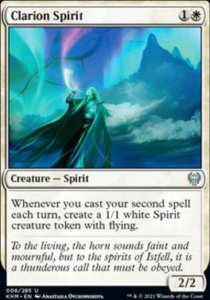
It’s very similar to the previously presented category – it costs two mana and its purpose is to create more than one creature. Compared to ‘Two mana get two 1/1s’ cards, Clarion Spirit has a lower floor and higher ceiling. It’s a disaster if you cast it and it dies before you can get a token out of it. But if you combine it with casting another spell, you’re already ahead compared to getting two 1/1s for one because the remaining token will have flying. It’s even better when the opponent doesn’t have removal and you can create one or two extra tokens – from my experience when it happens, it’s hard to lose a game unless there’s a sweeper involved. I’m still not 100% sure if Clarion Spirit is the best option available, but other alternatives fail to impress me and that’s why I keep playing it. But don’t be surprised if I switch to something else. Maybe there’s a two drop that waits to be discovered or just playing more one drops could be the solution?
Burning-Tree Emissary – should it be played? pros and cons
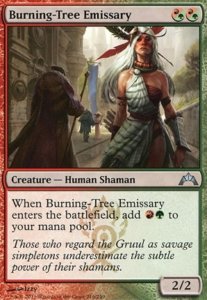
Since we are still in the early stages of deck development, there are many different decklists around. Players still test different mixes of cards, but if we had to separate Convoke players into two camps, this would be the place to draw the line. Some players (including myself) are against playing it while others are very high on it. Let’s analyse what Burning-Tree Emissary does for the deck, both from a positive and negative perspective.
Pros
- It plays extremely well with Reckless Bushwhacker.
- It allows us to develop more quickly.
Cons
- It’s not compatible with Jegantha.
- It’s hard to make use of the mana it generates sometimes. For example, in my list, it can cast Bushwhacker, Forbidden Friendship and one drops. It won’t help with two mana white spells and Convokers, assuming we don’t have a white creature in play. It’s possible to switch two mana enablers to support BTE more but they are just worse than Resolute Reinforcements.
- By itself, it’s a two mana creature that produces only one body, so usually, it’s a bad topdeck and a mediocre play if we don’t have anything to do with the mana.
All in all, Burning-Tree Emissary will be great when everything goes right and below average when something doesn’t go as we planned. Historically, this kind of aggro-combo strategies was first built in a way to maximise the most powerful openings but over time, being able to win games when the deck doesn’t want to function or the opponent has tools to stop us turned out to be more important. That’s why I (so far) opt to play Clarion Spirit over Burning-Tree Emissary – I want to make my lacklustre draws better, rather than maximising the good ones. At the end of the day, BTE is a two mana play that leaves only one body in play, so unless you have a Reckless Bushwhacker as a follow-up, you won’t contribute that much to a ‘go wide’ plan or meaningfully set up for Conkoving out the five drop. Time will tell if my intuition was right.
Payoffs
Convokers – Venerated Loxodon and Knight-Errant of Eos
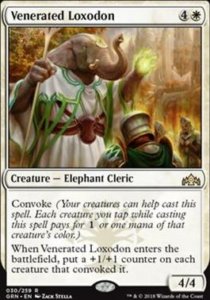
They both serve a similar role – they let you convert the resources you spent on building wide board states into an advantage, in the form of either more power on board or more cards in hand that will lead to more power on board in the next turn. The dream is to cast one of your Convokers on turn two, while turn three is a reasonable time when the cast should happen when the opponent doesn’t try to interfere. Don’t keep hands that don’t have a high chance of convoking on turn three.
When it comes to choosing between Loxodon and the Knight-Errant, there isn’t one golden rule about which one is better and should be cast first. Depending on the matchup, either securing card advantage or better board presence can be more impactful. My tip is to go for Loxodon if you want to deal early damage and if you are worried about the opponent having a lot of removal or you know you’ll have o go very wide to beat the opponent’s blockers, starting with Knight can be better because it will lead to casting more Convokers in the next turns. Note that Knight-Errant of Eos is more strict in terms of how many creatures convoke it – the more you tap this way, the better your Knight will be. The dream is to use only creatures, so you can grab Convokers and go off in the next turns as well. Another milestone is tapping three creatures – this means that you can grab Reckless Bushwhacker.
Reckless Bushwhacker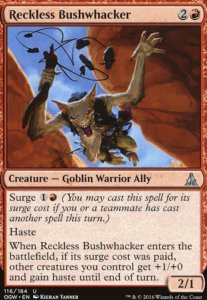
Bushwhacker is the main payoff for creating wide board states. Ideally, you want to cast it with Surge when your board overwhelms the opponent and you have lethal or close to it. Still, sometimes it’s fine to play it on turn two with Ornithopter, so you’ll have enough creatures to cast a Convoker on turn three, but this line of play should be used as a last resort. The fact that it gives your creatures haste means it’s a good way to take back an initiative after the opponent casts a sweeper. Always try to have an extra cheap spell in hand (ideally an Ornithopter, one drop is usually good enough as well), so you can cast Bushwhacker for its Surge cost when you topdeck it.
I tend to side out one copy often in matchups that don’t rely on speed because having multiple Bushwhackers in the opening hand can be clunky and leads to not being able to deploy Convokers. Still, the card is great and you should always keep in mind that you can either topdeck it or find it from Knight.
Flex slots
There are not enough cards that without doubt would fit into the strategy, so we are forced to play a few cards that are somewhat ok, but the deck could function without them as well. I tested a lot of different options (and I’ll probably try even more of them in the near future) and so far I found more than five playable alternatives.. Below, I wrote a few sentences about each one, so you won’t have to do the same work as I did.
My ideal flex slot card should:
- be cheap. Convoke wants to curve out nicely, so one mana cards are premium.
- work with the engine. Being a creature is important because it means they can be grabbed by Knight, even better if they interact with the rest of the team.
- impact the board not only in the early game, but also in later turns. The idea is to have something that will be relevant when it’s found by Knight.
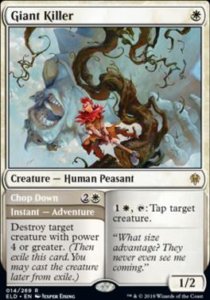
So far, it’s the best card for this slot and I recommend playing it over anything else on this list. On turn one it’s a one mana white creature, so it fits both into ‘go wide’ plan and convoking (thanks to its colour). In mid game, it can act as a removal spell for bigger creatures or a tapper – useful versus for example creatures with lifelink (Atraxa comes to mind).
Legion Loyalist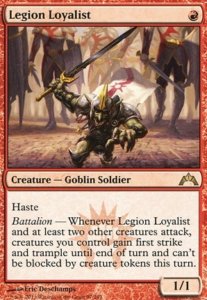
It’s a one drop with an ability that can be useful in some situations in mid game, so it should fit nicely into the deck. The problem is how random the effect is – it can randomly win you combats or do nothing because the opponent fights you on another axis. At the end of the day, it’s usually a 1/1 for 1 with haste, so nothing spectacular for Pioneer standards. I can see it being good in more creature-oriented metagames, but that’s it.
Legion’s Landing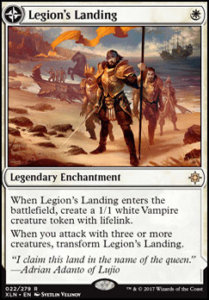
Some players are high on it, I’m more sceptical. It’s a noncreature spell, so by definition, it’s already behind compared to other options. On the plus side, it creates a white token with lifelink, which is both a relevant keyword and colour. I’m more worried about how the deck uses the other side of the card – if you attack with three creatures, Legion’s Landing flips and you get a land that for four mana can give you another creature. During my testing, I found both attacking early with creatures and spending my turn to get a 1/1 awkward. if the opponent doesn’t have creatures, sure, it’s a free mana source to get. But what if the opponent has strong defences set up? Or you want to cast convokers instead of attacking? And getting a 1/1 for four is the last thing you want to do and everything else is better than doing it. I’m not a fan, but who knows, maybe I’m missing something.
Skrelv, Defector Mite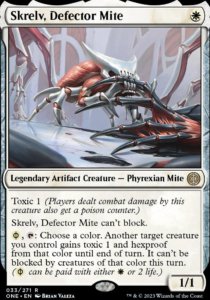
White one mana creature that’s also an artifact, so it’s a good start. The ability was also relevant in board stalls – it helped in pushing the damage through and protected Convokers or Clarion Spirit from removal. The only downside is that it’s good only if you play it early – when it’s found from Knight, it’s rarely impactful at all, since it can’t even block. Its protection ability also doesn’t work vs deck’s nemesis – sweepers. It’s a good card to consider in the future, but personally, I feel it comes a bit short.
Regal Leosaur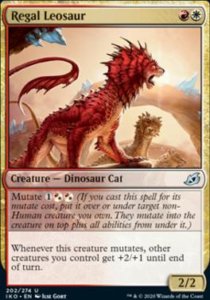
In the deck, it acts as extra copies of Reckless Bushwhacker. It looks solid in theory, but in practice with four Bushwhackers and four Knights to find them, I didn’t have problems finding this effect. That’s why I’m not sure if the deck wants even more of them. On top of that, Leosaur has one huge downside compared to Bushwhacker – if the opponent plays a removal in response, you won’t get a pump. I can see it being good as a one-off or a good sideboard option vs noninteractive decks that quickly produce big creatures and don’t play removal by themselves, for example Green Devotion.
Halo Hopper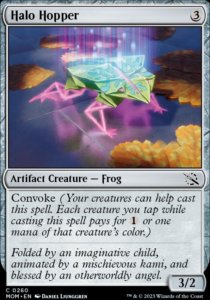
It’s too expensive to be considered an enabler and too weak to be counted as a payoff. It’s only good when you go turn one Ornithopter into Gleeful Demolition – having an extra 3/2 can create huge tempo swings. You can also cast it on turn two with one drop and two mana token makers, but that’s it. You also already have eight Convoke spells to support, so adding more of them can lead to clunky draws. The card is bad in multiples too since in ‘flood the board’ scenarios you want to attack before the opponent sets up defences and tapping your three creatures for a 3/2 body sounds bad. Maybe the first copy is worth a slot, but I’m sceptical.
Throne of the God-Pharaoh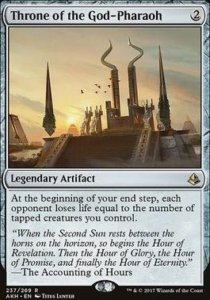
It’s an interesting way to win board stalls. To be honest with you, I have no idea if the card is good or not because I haven’t cast it yet. Time will tell if it’s good or not.
Plargg, Dean of Chaos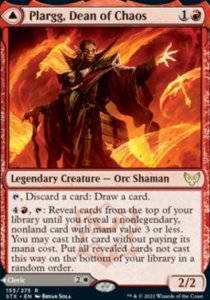
Don’t touch it, it’s super shitty. Regal Leosaur is a much better option than that.
The manabase
The deck often operates on low land counts, so our lands should:
- enter the battlefield untapped as often as possible
- produce both red and white, so we can curve out without problems
Sacred Foundry, Inspiring Vantage, and Battlefield Forge are self-explanatory – they cover both checkboxes, so you want to max out on them. Mana Confluence is another land that does it, but the cost of it is steep, especially in racing situations. Having one or two should be acceptable in terms of the pain you get for getting the colours you need, but I don’t recommend playing more than that. Since the rest of the manabase I recommend is red, I felt I wanted to increase my count of white sources from fourteen to fifteen, so I decided to add the next best option we have – Needleverge Pathway. So far I’m happy with my setup for white mana, but I can see it being even better in the future, so don’t be surprised if it evolves a bit moving forward.
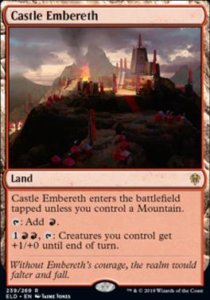
Fifteen lands are locked for white sources, so the question was how many other lands the deck should run. Early versions had seventeen lands, but it was clearly not enough, so people started adding more. At first, it was eighteen, then eighteen with Legion’s Landings, but when I was testing it, I found it wasn’t enough. These extra slots were used to give the deck additional powerful effects, such as Regal Leosaur. I also tried Shefet Dunes to have an extra anthem effect when I got flooded, but with only eighteen lands, it was hard to get to the fifth one on board. Eventually, it turned out that there was something cheaper and better suited for the deck. Instead of random creatures that were good on paper, but I never had mana for them, I decided to include Castle Embereth – you need not five, but four lands to use it, you don’t have to sacrifice it, so more than one use is available. The problem was that it entered the battlefield tapped quite often. The solution was simple – play it in the spells slot and add Mountains to increase chances to play it untapped. As a result, instead of eighteen lands, I went up to twenty lands with two Castles and I never looked back. Overall, I like the manabase in the deck, although I can see a problem of having draws with only red sources and white spells in hand, but that’s the price we pay for an extra anthem effect – in my opinion it’s totally worth it. There are also other interesting lands to play like Sokenzan, Crucible of Defiance, Den of the Bugbear, Shefet Dunes, etc., but in my opinion, Castle Embereth’s power level just outclasses every one of them.
Sideboard options
Personally, I feel that this section of the deck is the most underdeveloped. Some cards are most likely here to stay, but there’s still plenty of room for upgrades. I expect the sideboard of this deck to change in the upcoming weeks. So instead of giving you one, 100% correct sideboard, I wrote down my thoughts about each card – when it shines, how much is it needed and what are the risks of relying on them. Enjoy!
Frontrunners
Jegantha, the Wellspring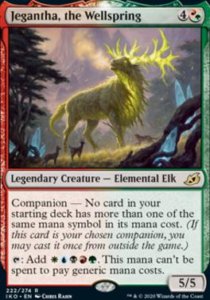
If you don’t play Burning-Tree Emissary, you should probably play a Companion. In this deck you won’t use it that often, but if you can have an extra resource for free, you should probably opt for it. It can be used as a vanilla 5/5 or a card to discard when you use a Blood token.
Rending Volley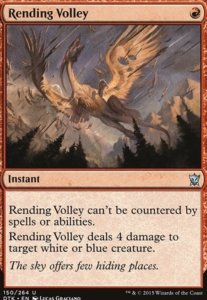
If I had to bet which card will be in this deck’s sideboard a month from now, I would choose Rending Volley. It’s a very efficient removal versus some of the most popular decks in the format – Humans, Spirits, Greasefang, as well as against more exotic strategies like Angels, Auras, and Rona combo. I don’t mind having as much as four copies in my sideboard, although it’s rare to find that many slots in the sideboard.
Invasion of Gobakhan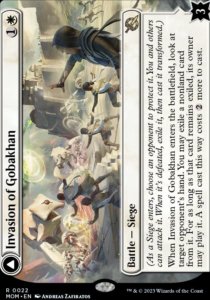
Since the sweepers in Pioneer decks are very different from each other, it’s hard to have one card to cover them all. For example, some of them are damage-based, others can destroy creatures, or exile them, so the only good answers for them would be a countermagic or a discard effect. Invasion of Gobakhan is as close as we can get to these in Boros colours. It will give you information about the opponent’s plan and delay their best card (quite often it’s not the most expensive one, but the one that’s critical for early game). You can also attack the battle and once you flip it, it becomes a long-term win condition and a protection from some forms of sweepers. Invasion of Gobakhan can be awkward, especially on the draw because using two mana for this effect instead of casting cheap creatures can set you back significantly, but it’s the best tool we have access to. And of course, sometimes it’s the best line of play when we are on the play: turn one Ornithopter + Gleeful Demolition into Invasion should win versus any heavy removal deck.
Right now most lists have three copies, but I can see it going in both directions – four off in all sideboards or not played at all, depending on how unified the hate against Convoke will turn out to be – the less variety in hate cards, the more likely it’ll be to find some more efficient tool to fight this small subset rather than a broad-spectrum tool like the Invasion.
Forge Devil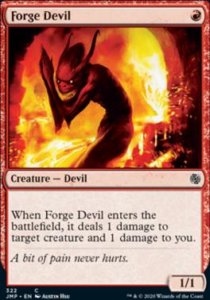
If you are worried that you can be tempo’d out by the opponent who plays x/1 creatures in the early turns of the game, Forge Devil is your best friend. Its main purpose is to kill Llanowar Elves and x/1 human one drops like Recruitment Officer. It shines when you are on the draw, when catching up on tempo is that much more important. I can see it being played from zero to three copies in the sideboard, depending on how often you expect to face Devotion and Humans.
End the Festivities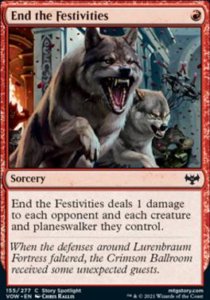
While it looks similar to Forge Devil, it has a different purpose – it’s mainly to win the mirror. It can be awkward sometimes, especially if the opponent goes for Gleeful Demolition into Loxodon, but most of the time, you should find a situation when this card kills multiple creatures for just one mana. It can also be somewhat good versus Humans or Llanowar Elves decks, but I’m less excited to use it there than the Devil.
Possible additions
Pithing NeedleIt’s cheap, it’s an artifact, and it can stop entire strategies. Its main use is to name Karn, the Great Creator or Polukranos, the Reborn vs Mono Green and stop other combo decks like Lotus (you name Thespian Stage, although it won’t stop them from eventually combo out, so think about it as a way to slow them down rather than an “I win” button) or Rona combo (you name Rona, Herald of Invasion). It’s also fine to side in one copy vs UW Control and name either The Wandering Emperor or Teferi, Hero of Dominaria. Personally, I like having at least one copy of Pithing Needle in my sideboard, but I wouldn’t be surprised to see zero, two or even three copies.
Surge of SalvationIf it turns out that the main weapon of choice versus Convoke will be red sweepers like Brotherhood’s End or Deafening Clarion, Surge of Salvation can be a nice answer to them.
Tormod’s CryptThe card has one huge upside – it’s an artifact for zero mana, so it works beautifully with Gleeful Demolition. But that’s sadly all there’s to it – it’s a narrow card for problems that can be dealt with in other ways. The best use of it is probably to keep Greasefang in check, but we already have Rending Volley for it.
Wedding AnnouncementIt’s a powerful card, but it doesn’t fit that well with what the deck is trying to do. At first, everyone was playing four copies in the sideboard, but it was slowly trimmed. When I won the Pioneer Challenge, I had only two copies as a way to grind better vs RB Midrange, but even there, it wasn’t spectacular and I often wanted to cast something else on turn three, preferably a Convoker. I’m not sure if the card will be played in the archetype moving forward, but I decided to post it here, so you won’t shove a full playset into your sideboard for no good reason.
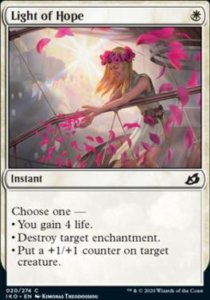
It’s a good example of a narrow but effective answer to a problematic card Convoke faces a lot – Temporary Lockdown. If you use it with the exiling trigger on the stack, nothing will happen and even your tokens will survive. It’s also a great tool to deal with powerful enchantments like Enigmatic Incarnation. So far I’ve been liking Light of Hope more because of its modality, simply because there aren’t any decks that play artifacts I would like to destroy with Wear//Tear.
Magmatic Chasm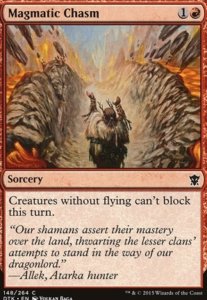
In the early development of the deck, it was used to win through board stalls. Nowadays, it’s probably better to use something like Regal Leosaur. It may be a solution to the mirror because if you don’t have an early Loxodon, it usually comes down to the situation when both players have thirty or more power and can’t do anything about it, but I’m not brave enough to say that it’s a good tech just yet. More testing is required.
Gameplay
Boros Convoke is a linear deck – it always tries to do one, the same thing, and by this I mean to put a lot of shitty creatures on board and cast something to use them get an advantage on board, either a Convoker or Reckless Bushwhacker. The deck is also filled with bad Magic cards that can shine only if you get a critical mass of them early in the game or have a payoff card ready. That’s why sequencing and looking for opportunities to squeeze a few damages here and there or maximize the efficiency of using Convokers can be a difference between winning and losing. The deck has an autopilot mode, especially when turn two Gleeful Demolition into a Convoker happens, but most of the time, you’ll have to choose right from a huge decision tree you’ll have. That’s why I recommend spending some time goldfishing, so you’ll learn the basic lines the deck can present. To make it easier for you, I prepared three scenarios that will describe most of the deck’s openings.
Possible goldfish scenarios
1/1 aggro
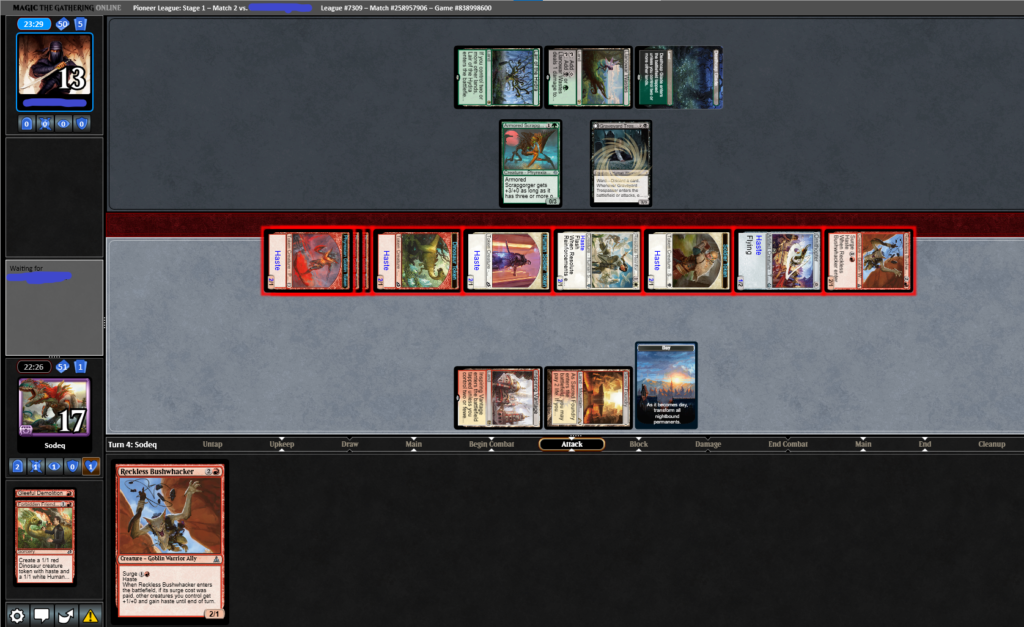
This line of play is super straightforward – just cast your enablers, attack with everything you have and hope that’s enough. The ideal start is an early Gleeful Demolition (ideally on turn one with Ornithopter) with more ‘create two 1/1s’ effects on later turns. This strategy is effective against decks filled with one for one creature removal spells and not a lot of creatures. It will struggle though if the opponent will be able to play two or more blockers – chump attacking into those won’t be effective until you create an overwhelming advantage on the board. Reckless Bushwhacker also helps in these scenarios, so you can push final damage through.
Knight into Bushwhacker
It’s probably the hardest plan to achieve and for sure it requires the biggest setup. The idea is to play Knight-Errant of Eos and start building an advantage that in future turns will lead to lethal boards. It’s harder compared to fast Loxodon because it’s more fragile in terms of the number of creatures you need to have on board. Loxodon starts don’t care if you’ve used four or five creatures, as long as you do it early in the game. It’s a different story with Knight since the power of the trigger is more heavily related to the number of creatures that convoked it – the difference between four and five is massive. The best scenario is when you use it for five in the early game since you’ll be able to grab any creature from the deck, including more Knights to keep going in future turns. This can lead to questions – should you use your 4/4 Knight that’s already in play to get to X=5 or attack instead? There aren’t any golden rules for that and it’s very matchup dependent. The longer the game goes, the more likely it is that you’ll want to find Reckless Bushwhacker to swing for lethal rather than another Convoker. It’s even quite common to tap three creatures to cast a Knight and Surge Bushwhacker on the same turn – you won’t attack with three 1/1s, but a hasty 5/4 will compensate you for your losses.
Fast Loxodon
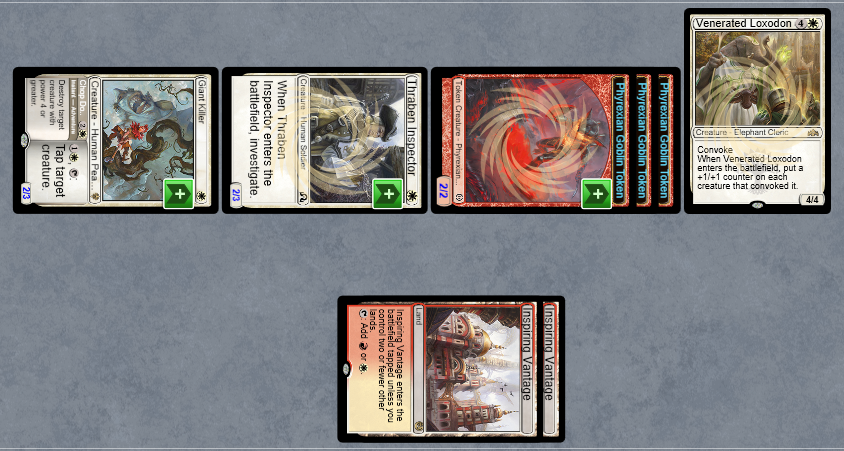
Personally, this is my favourite line of play. Your goal is to put early creatures and pump them with Loxodon. My personal record was to get sixteen power on turn two (T1 Ornithopter Demolition, turn two Inspector, Demolition and Loxodon). Once you get there, just attack until the opponent is dead. It’s much easier and less complicated than the lines with Knight-Errant of Eos.
Keep or mulligan
Boros Convoke is a linear deck, so mulliganing is relatively simple – if you have two or more lands and ways to produce tokens early, you should probably keep the hand. I’m not a fan of mulliganing to a Convoker – your average hand (by this I mean a chance to cast a Convoker on turn three if you have it or happen to topdeck it) should be competitive against most of the decks in the format. There are some situations when keeping one landers is correct though – you need to have a Gleeful Demolition, at least two of either Thraben Inspector (better) or Voldaren Epicure (a bit worse) and a Convoker. It’s a lot to ask for, but these situations can happen and you should be able to recognize them as very good rather than mulligans.
I prepared a few hands for you, so you can see the basic rules of sideboarding and guidelines on what you should expect when you play this deck.
Perfect hand

Turn two fourteen power is where you always want to be. Here you have even two routes to get there, T1 Ornithopter + Demolition into T2 Forbidden Friendship or T1 Inspector into T2 Demolition, Thopter.
Solid hands

Guaranteed turn three Knight-Errant of Eos + Castle for mid game. Additional upside of having artifact makers so topdecking Gleeful Demolition would be insane.

Again, solid turn three Knight. The one thing that can be problematic is the lack of a third land, so one removal on our early creatures can delay convoking.

Ten power on turn two with the potential for more if we topdeck a cheap creature – sign me up.

On the surface, it looks like a perfect hand, but the manabase doesn’t cooperate with us here. Still, it’s a solid keep. I would start with Pathway into Inspector. If you topdeck a red source, it’s a perfect hand, if not, it’s a solid T3 Loxodon, so still fine.

Something for BTE enjoyers – a hand without a Convoker, but I would be happy to have it. Doesn’t matter if you cast Burning-Tree Emissary with Bushwhacker on turn three or four, it’s twenty two damage by the end of turn four.

Turn one Ornithopter + Gleeful Demolition, turn two Invasion of Gobakhan, and more creatures on turn three. It’s a death sentence for most of the decks in the format.
Hands that are fine, but not spectacular

You have a solid curve, but the lack of Convoker is something that makes this hand unimpressive. Clarion Spirit is solid here because it makes the hand much better if you know what you are playing against. If you know the opponent doesn’t have removal, casting it on turn two into (depending on what your draws are) immediate Ornithopter or next turn Friendship + Thopter or even Thopter + Bushwhacker can flood the board pretty quickly.

Solid curve but without a Convoker. Good for 1/1 aggro, and it has a lot of good topdecks.

The lack of Convoker (do you see a pattern here?) and having four lands already in hand are reasons to potentially mulligan it, but in my opinion, Castle Embereth saves this hand.
Traps

The hand looks cool at first glance, but it doesn’t have any artifact producer. Easy mulligan.

Reckless Bushwhacker is not a good enabler. I would keep it if it was any creature for one or two mana instead.
Random tips
- Don’t be afraid to attack with your wide boards of 1/1s into one blocker. Dealing five or more damage for the cost of losing one token is usually worth it – it means that the opponent’s life total will be low enough to finish them with Bushwhacker. And even if you don’t have it, just make more tokens and overwhelm their defences.
- If you expect the opponent to have a removal ready and you have three creatures on board, two lands open, Resolute Reinforcements and a Convoker, it’s better to convoke ASAP by tapping two lands. Yes, two 1/1s for two are mana neutral and going for X=5 can be great, but if the opponent kills one of your creatures in response to the token maker, you won’t be able to convoke at all. Sometimes it’s not about getting all the value in the world but safely deploying a 4/4.
- Gleeful Demolition can destroy opposing artifacts!
- You can cast Reckless Bushwhacker for three mana, don’t forget about it.
- Forge Devil’s ability doesn’t have a ‘may’ clause, so don’t play it on the empty board, unless you really want your Forge Devil to die.
- When you sequence your early creatures, check twice to not bottleneck yourself on mana. For example, when you have Mountain, Inspiring Vantage, two Thabern Inspector and Voldaren Epicure, start with one of the Inspectors
- When you fight versus Make Disappear, it’s usually correct to slow roll your Convokers and play more enablers instead. If they let you resolve them, you can cast your Knight or Loxodon without using lands, so you will be ready to pay for the Disappear.
BONUS: the list I would play at LMS Valencia or any RCQ this weekend
Since many of you were asking me about what list I would play and if there will be a sideboard guide before Valencia, I decided to prepare a short version for those of you battling this weekend. It won’t be as detailed as a typical sideboard guide that’s posted on Mystical Teachings, but time was an issue for me. I expect to finish a full, solid sideboard guide by the end of next week, once I play the deck more and answer a few more questions I have. So far, I came down to this list. It’s probably not ideal and some things may change in the future, but it’s the best I can give you for now.
Short answers to the questions you can have:
- 3x Giant Killer and 3x Clarion Spirit – they are both in the flex slot territory. I believe there are two best options we have for the deck and I’m happy with having them both as three-ofs. In the near future, I’ll reconsider playing one or two Skrelvs to protect Clarion Spirits, assuming I’ll stay in the Clarion Spirit camp.
- 4x Resolute Reinforcements and 2x Forbidden Friendship – I value the flash aspect of Reinforcements very highly, especially in postboard games, so we can play around sweepers better. I also think that having more hits for Knight is a step in the right direction.
- End the Festivities is my plan vs mirror. I tested Legion Loyalist in this slot and it was quite bad. I know that End the Festivities also isn’t always great (for example it sucks after the opponent plays Loxodon), but it’s the best that I’ve found so far. Maybe Magmatic Chasm could be better?
- I’m also not the biggest fan of Wedding Announcement and I can see it being cut from the sideboard entirely, but I don’t have any other idea how to approach a RB Midrange matchup and not siding in anything vs the most popular deck in the format doesn’t feel good.
- Light of Hope may look strange at first glance, but every time I side it in and draw it, it’s great. I’m closer to playing two copies than zero.
Mini sideboard guide
RB Midrange
+2 Wedding Announcement
-1 Ornithopter -1 Forbidden Friendship
Mono Green
+2 Forge Devil +1 Pithing Needle
-1 Voldaren Epicure -1 Resolute Reinforcements -1 Giant Killer
UW Control
+3 Invasion of Gobakhan +1 Pithing Needle +1 Light of Hope (only if they have Temporary Lockdowns)
-1 Giant Killer -1 Loxodon -1 Ornithopter P: -1 Voldaren Epicure D: -1 Ornithopter
if you also side in Light of Hope: -1 Ornithopter
Abzan Greasefang
+3 Rending Volley +1 Pithing Needle
-1 Clarion Spirit -1 Forbidden Friendship -1 Giant Killer -1 Voldaren Epicure
Humans
+3 Rending Volley +2 Forge Devil
-2 Giant Killer -2 Forbidden Friendship -1 Reckless Bushwhacker
(Maybe Wedding Announcement on the play could be good, but I haven’t tested it yet. You can also try to surprise the opponent with End the Festivities, but once the opponent knows you have it, it’s easy to play around with their counters)
Incarnation
+3 Invasion of Gobakhan +1 Light of Hope
-1 Giant Killer -1 Forbidden Friendship -1 Reckless Bushwhacker P: -1 Voldaren Epicure D: -1 Ornithopter
Boros Convoke
+2 End the Festivities P: +2 Wedding Announcement D: +2 Forge Devil
-3 Giant Killer -1 Reckless Bushwhacker
(I’m not sure about extra play//draw effects to be honest since both options are not the best ones, but I haven’t found any better plan and Giant Killers are an easy side out anyway)
